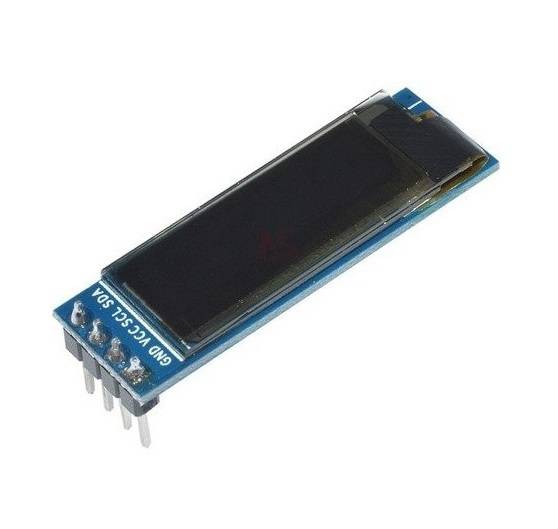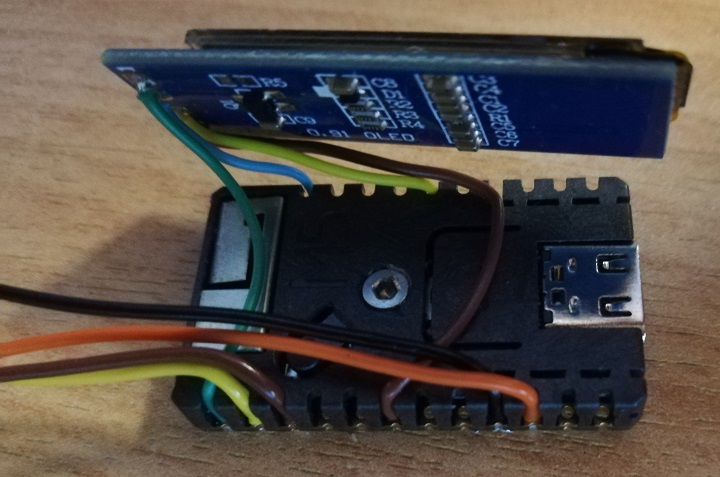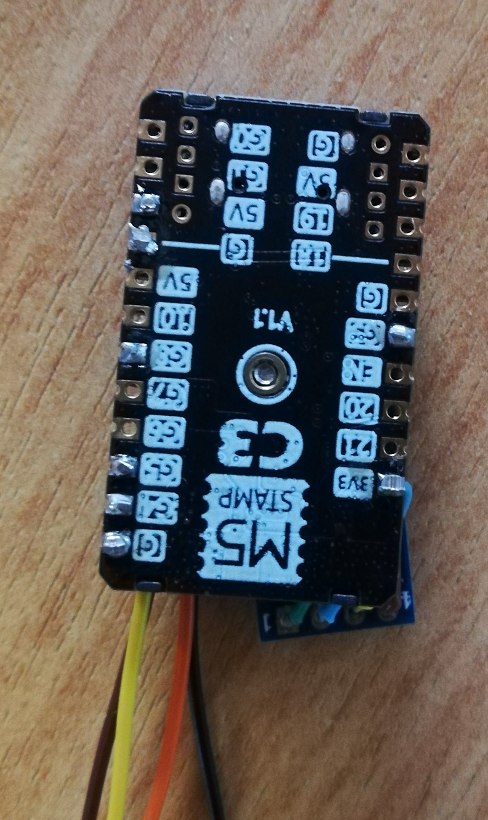| (26 révisions intermédiaires par le même utilisateur non affichées) | |||
| Ligne 13 : | Ligne 13 : | ||
}} | }} | ||
{{Introduction | {{Introduction | ||
| − | |Introduction=Ce système | + | |Introduction=Ce système permet d'arroser automatiquement une plante et informe l'utilisateur du pourcentage d'humidité. Le matériel est conçu pour être modulaire (trois modules: pompe avec capteur d'humidité, ESP32 C3 et écran monochrome OLED 0.91") facile à implémenter. |
}} | }} | ||
{{Materials | {{Materials | ||
| Ligne 50 : | Ligne 50 : | ||
}} | }} | ||
{{Tuto Step | {{Tuto Step | ||
| − | |Step_Title=Boitier (impression 3D) | + | |Step_Title=Boitier (impression 3D) et assemblage |
| + | |Step_Content=*Le boitier du système se compose de trois parties (capot supérieur, couvercle inférieur et la partie latérale) cette décomposition facilite l'impression 3D, la maintenance du système et l'accès à ses composantes électroniques. | ||
| + | Lien Thingiverse vers le fichier format F3D | ||
| + | https://www.thingiverse.com/thing:5487673 | ||
| + | |||
| + | *Le boitier peux être imprimé sans utilisation de mâtereaux support et sans paramètres particuliers. | ||
| + | *le boitier est des dimensions (38mm*18.5mm*14mm) permet d'accueillir le M5Stamp C3 l'afficheur OLED et le connecteur HY2.0 4P. | ||
| + | '''L'assemblage consiste à utiliser la colle à chaud:''' | ||
| + | ''M5Stamp C3 est collé sur le capot inférieur de telle façon soit accessible par USB-C du côté et on fixe de l'autre côté le connecteur HY2.0 4P.'' | ||
| + | ''Enfin l'afficheur OLED et coller sur le couvercle supérieur de tell façon que toute la partie d'affiche soi visible.'' | ||
|Step_Picture_00=Système_d'arrosage_automatique_IMG_20220704_221436.jpg | |Step_Picture_00=Système_d'arrosage_automatique_IMG_20220704_221436.jpg | ||
|Step_Picture_01=Système_d'arrosage_automatique_IMG_20220704_221336.jpg | |Step_Picture_01=Système_d'arrosage_automatique_IMG_20220704_221336.jpg | ||
| + | |Step_Picture_02=Arrosage_automatique_Capture_d_cran_2022-08-29_230406.png | ||
| + | |Step_Picture_03=Arrosage_automatique_Sans_nom_v5.png | ||
| + | |Step_Picture_04=Arrosage_automatique_Capture_d_cran_2022-08-29_231623.png | ||
}} | }} | ||
{{Tuto Step | {{Tuto Step | ||
|Step_Title=Programmation | |Step_Title=Programmation | ||
| − | |Step_Content= | + | |Step_Content=Micropython code for ESP32 M5Stamp C3 microcontroller |
| − | + | OLED dispaly 128*32 with I2C | |
| − | + | M5STACK Watering Unit - Soil Moisture Sensor and Water Pump | |
| − | + | import of libraries | |
| − | + | from machine import Pin, SoftI2C, ADC | |
| − | from machine import Pin, SoftI2C, ADC | + | from time import sleep |
| − | from time import sleep | + | import ssd1306 |
| − | import ssd1306 | + | import gfx |
| − | import gfx | + | import framebuf |
| − | import framebuf | + | Pin for moisture sensor |
| − | + | moisure = ADC(Pin(4)) | |
| − | + | Attenuation of the ADCA gain for analog read | |
| − | moisure = ADC(Pin(4)) | + | moisure.atten(ADC.ATTN_11DB) |
| − | + | Pin for pump control | |
| − | moisure.atten(ADC.ATTN_11DB) | + | pump = Pin(6, Pin.OUT) |
| − | + | Threshold irrigation point | |
| − | pump = Pin(6, Pin.OUT) | + | threshold_point = 45 |
| − | + | I2C setup and initialisation | |
| − | threshold_point = 45 | + | i2c = SoftI2C(scl = Pin(9), sda = Pin(8)) |
| − | + | OLED object creation and setup | |
| − | + | oled = ssd1306.SSD1306_I2C(128,32,i2c) | |
| − | i2c = SoftI2C(scl = Pin(9), sda = Pin(8)) | + | bytearray of empty droplet icon |
| − | + | droplet = bytearray(b'\x00\x00\x00\x00\x00\x00\x00\x00\x00\x00\x00\x00\x00\x01\x80\x00\x00\x03\xc0\x00\x00\x02@\x00\x00\x06`\x00\x00\x0c0\x00\x00\x08\x10\x00\x00\x18\x18\x00\x00\x10\x08\x00\x000\x0c\x00\x00`\x06\x00\x00@\x02\x00\x00@\x02\x00\x00\xc0\x03\x00\x00\x80\x01\x00\x00\x80\x01\x00\x01\x80\x01\x80\x01\x00\x00\x80\x01\x00\x08\x80\x01\x00\x08\x80\x00\x80\t\x00\x00\x80\x19\x00\x00\xc03\x00\x00A\xe6\x00\x000\x0c\x00\x00\x18\x18\x00\x00\x07\xe0\x00\x00\x00\x00\x00\x00\x00\x00\x00\x00\x00\x00\x00') | |
| − | oled = ssd1306.SSD1306_I2C(128,32,i2c) | + | bytearray of smiley face icon |
| + | smiley_face = bytearray(b'\x01\xf0\x00\x06\x0e\x00\x18\x01\x00\x10\x00\xc0 \x00@@\x00 C\x08 \x81\x0c \x80\x00\x10\x80\x00\x10\x80\x00\x10\x88\x01\x10\x84\x02 F\x04 A\x9c `@0\x00\x80\x08\x01\x80\x07\x0e\x00\x01\xf0\x00') | ||
| + | bytearray of sad face icon | ||
| + | sad_face = bytearray(b'\x01\xf8\x00\x06\x06\x00\x18\x01\x80\x10\x00\x80 \x00@@\x00 A\x08 \x83\x0c \x80\x00\x10\x80\x00\x10\x80\x00\x10\x81\xf8\x10\x82\x04 D\x02 L\x02` \x00@0\x00\x80\x08\x01\x80\x07\x0e\x00\x01\xf0\x00') | ||
| + | bytearray of filled droplet icon | ||
| + | icon = [ | ||
| + | [0,0], | ||
| + | [0,0], | ||
| + | [0,0], | ||
| + | [0,0], | ||
| + | [0,0], | ||
| + | [16,2], | ||
| + | [16,2], | ||
| + | [15,4], | ||
| + | [14,6], | ||
| + | [14,6], | ||
| + | [13,8], | ||
| + | [12,10], | ||
| + | [12,10], | ||
| + | [11,12], | ||
| + | [11,12], | ||
| + | [11,12], | ||
| + | [10,14], | ||
| + | [10,14], | ||
| + | [10,14], | ||
| + | [10,14], | ||
| + | [10,14], | ||
| + | [10,14], | ||
| + | [10,14], | ||
| + | [10,14], | ||
| + | [11,12], | ||
| + | [11,12], | ||
| + | [13,8], | ||
| + | [15,4], | ||
| + | [0,0], | ||
| + | [0,0], | ||
| + | [0,0], | ||
| + | [0,0], | ||
| + | ] | ||
| + | Creation of frame buffer from icons | ||
| + | frameD = framebuf.FrameBuffer(droplet, 32, 32, framebuf.MONO_HLSB) | ||
| + | frameH = framebuf.FrameBuffer(smiley_face, 20, 20, framebuf.MONO_HLSB) | ||
| + | frameS = framebuf.FrameBuffer(sad_face, 20, 20, framebuf.MONO_HLSB) | ||
| − | + | defintion of values converting function in range (min, max) | |
| − | + | def convert(x, in_min, in_max, out_min, out_max): | |
| − | + | return (x - in_min) * (out_max - out_min) // (in_max - in_min) + out_min | |
| − | |||
| − | |||
| − | |||
| − | |||
| − | |||
| − | |||
| − | |||
| − | |||
| − | |||
| − | |||
| − | |||
| − | |||
| − | |||
| − | |||
| − | |||
| − | |||
| − | |||
| − | |||
| − | |||
| − | |||
| − | |||
| − | |||
| − | |||
| − | |||
| − | |||
| − | |||
| − | |||
| − | |||
| − | |||
| − | |||
| − | |||
| − | |||
| − | |||
| − | |||
| − | |||
| − | |||
| − | |||
| − | |||
| − | |||
| − | |||
| − | |||
| − | |||
| − | + | LmoisureLevel = [] | |
| − | + | AvmoisureLevel = 0 | |
| − | |||
| − | + | get 50 values of moisture and calculate the average | |
| − | + | while True: | |
| − | + | moisureLevel = moisure.read() | |
| − | + | LmoisureLevel.append(moisureLevel) | |
| − | while True: | + | if len(LmoisureLevel) == 50: |
| − | + | AvmoisureLevel = sum(LmoisureLevel)/50 | |
| − | + | LmoisureLevel.pop(0) | |
| − | + | AvmoisureLevel = int(AvmoisureLevel) | |
| − | + | moisure_string = str(AvmoisureLevel) | |
| − | + | clear OLED display | |
| − | + | oled.fill(0) | |
| − | + | display texte | |
| − | + | oled.text('My plant!',10,0) | |
| − | + | Convert the analog value to moisture level (0%-100%) | |
| − | + | AvmoisureLevel = convert(AvmoisureLevel, 1860, 2550, 100, 0) | |
| − | + | w = int(AvmoisureLevel/3.3) | |
| − | + | display moisture level | |
| − | + | oled.text(str(AvmoisureLevel) +"%",4,20) | |
| − | + | display emplty droplet icon | |
| − | + | oled.blit(frameD, 100, 0) | |
| − | + | display droplet level | |
| − | + | for y,row in enumerate(icon): | |
| − | + | for p in range(row[1]): | |
| − | + | if (y < 32 - w): | |
| − | + | oled.pixel(99+row[0]+p,y,0 ) | |
| − | + | else: | |
| − | + | oled.pixel(99+row[0]+p,y,1) | |
| − | + | Control pump at given threshold point and display emoji | |
| − | + | if(AvmoisureLevel < threshold_point): | |
| − | + | pump.value(1) | |
| − | + | oled.blit(frameS, 60, 12) | |
| − | + | else: | |
| − | + | pump.value(0) | |
| − | + | oled.blit(frameH, 60, 12) | |
| − | + | oled.show() | |
| − | |||
| − | |||
| − | |||
| − | |||
|Step_Picture_00=Système_d'arrosage_automatique_Micropython-logo.svg_-768x782.png | |Step_Picture_00=Système_d'arrosage_automatique_Micropython-logo.svg_-768x782.png | ||
}} | }} | ||
| − | {{Notes}} | + | {{Notes |
| + | |Notes='''Références:''' | ||
| + | <u>https://docs.micropython.org/en/latest/esp32/quickref.html</u> \\ | ||
| + | <u>https://github.com/adafruit/Adafruit_SSD1306</u> \\ | ||
| + | <u>https://docs.m5stack.com/en/unit/watering</u> | ||
| + | }} | ||
{{Tuto Status}} | {{Tuto Status}} | ||
Version actuelle datée du 2 novembre 2022 à 12:05
Une Création de dans les catégories Électronique, Maison, Robotique, Science & Biologie, Alimentation & Agriculture. Dernière modification le 2/11/2022 par Mmoumni.
système d'arrosage automatique miniature, connecté sur cloud ou en local. Permets d'arroser de façon autonome une plante en fonction de l'humidité de la terre.
Introduction
Ce système permet d'arroser automatiquement une plante et informe l'utilisateur du pourcentage d'humidité. Le matériel est conçu pour être modulaire (trois modules: pompe avec capteur d'humidité, ESP32 C3 et écran monochrome OLED 0.91") facile à implémenter.
Liste des matériaux
- Un module pompe avec capteur d'humidité intégrer ( = 12 €)
- Un microcontrôleur type ESP32 ( = 8 €)
- Une afficheur OLED 0.91" I2C ( = 4 €)
- connecteur femelle type HY2.0 4P ( = 0.6 €)
- Fils souple (coloré)
Liste des outils
- Une imprimante 3D avec ces outils
- Logiciel de conception 3D (CAO)
- Ordinateur (PC, Raspberry pi 3 ou 4, ...) avec logiciel IDE Thonny
- Fer à souder et étain
- pinces de sertissage / dénudage
Etape n°1 - câblage
Choix des fils:
- Les fils standard de câblage d'électroniques section max 0.3mm²
- préférable de choisir les couleurs noir et rouge pour les alimentations et des autres couleur pour GPIO.
NB: ce projet nécessite peu des fils (langueur total max 20 cm)
Câblage du ESP32 et l'afficheur OLED et connecteur HY2.0-4P câbler les 3 éléments comme indiquer dans le diagramme (voir figure), utiliser des langueurs des fils la plus court possible, sachant que l'afficheur sera monté juste en haute du ESP32 et le connecteur juste à coté d'antenne (ESP32), cela permet de mettre l'ensemble dans un petit boitier.
Etape n°2 - Boitier (impression 3D) et assemblage
- Le boitier du système se compose de trois parties (capot supérieur, couvercle inférieur et la partie latérale) cette décomposition facilite l'impression 3D, la maintenance du système et l'accès à ses composantes électroniques.
Lien Thingiverse vers le fichier format F3D https://www.thingiverse.com/thing:5487673
- Le boitier peux être imprimé sans utilisation de mâtereaux support et sans paramètres particuliers.
- le boitier est des dimensions (38mm*18.5mm*14mm) permet d'accueillir le M5Stamp C3 l'afficheur OLED et le connecteur HY2.0 4P.
L'assemblage consiste à utiliser la colle à chaud: M5Stamp C3 est collé sur le capot inférieur de telle façon soit accessible par USB-C du côté et on fixe de l'autre côté le connecteur HY2.0 4P. Enfin l'afficheur OLED et coller sur le couvercle supérieur de tell façon que toute la partie d'affiche soi visible.
Etape n°3 - Programmation
[[Step_Content::Micropython code for ESP32 M5Stamp C3 microcontroller OLED dispaly 128*32 with I2C M5STACK Watering Unit - Soil Moisture Sensor and Water Pump import of libraries
from machine import Pin, SoftI2C, ADC from time import sleep import ssd1306 import gfx import framebuf
Pin for moisture sensor
moisure = ADC(Pin(4))
Attenuation of the ADCA gain for analog read
moisure.atten(ADC.ATTN_11DB)
Pin for pump control
pump = Pin(6, Pin.OUT)
Threshold irrigation point
threshold_point = 45
I2C setup and initialisation
i2c = SoftI2C(scl = Pin(9), sda = Pin(8))
OLED object creation and setup
oled = ssd1306.SSD1306_I2C(128,32,i2c)
bytearray of empty droplet icon
droplet = bytearray(b'\x00\x00\x00\x00\x00\x00\x00\x00\x00\x00\x00\x00\x00\x01\x80\x00\x00\x03\xc0\x00\x00\x02@\x00\x00\x06`\x00\x00\x0c0\x00\x00\x08\x10\x00\x00\x18\x18\x00\x00\x10\x08\x00\x000\x0c\x00\x00`\x06\x00\x00@\x02\x00\x00@\x02\x00\x00\xc0\x03\x00\x00\x80\x01\x00\x00\x80\x01\x00\x01\x80\x01\x80\x01\x00\x00\x80\x01\x00\x08\x80\x01\x00\x08\x80\x00\x80\t\x00\x00\x80\x19\x00\x00\xc03\x00\x00A\xe6\x00\x000\x0c\x00\x00\x18\x18\x00\x00\x07\xe0\x00\x00\x00\x00\x00\x00\x00\x00\x00\x00\x00\x00\x00')
bytearray of smiley face icon
smiley_face = bytearray(b'\x01\xf0\x00\x06\x0e\x00\x18\x01\x00\x10\x00\xc0 \x00@@\x00 C\x08 \x81\x0c \x80\x00\x10\x80\x00\x10\x80\x00\x10\x88\x01\x10\x84\x02 F\x04 A\x9c `@0\x00\x80\x08\x01\x80\x07\x0e\x00\x01\xf0\x00')
bytearray of sad face icon
sad_face = bytearray(b'\x01\xf8\x00\x06\x06\x00\x18\x01\x80\x10\x00\x80 \x00@@\x00 A\x08 \x83\x0c \x80\x00\x10\x80\x00\x10\x80\x00\x10\x81\xf8\x10\x82\x04 D\x02 L\x02` \x00@0\x00\x80\x08\x01\x80\x07\x0e\x00\x01\xf0\x00')
bytearray of filled droplet icon
icon = [
[0,0],
[0,0],
[0,0],
[0,0],
[0,0],
[16,2],
[16,2],
[15,4],
[14,6],
[14,6],
[13,8],
[12,10],
[12,10],
[11,12],
[11,12],
[11,12],
[10,14],
[10,14],
[10,14],
[10,14],
[10,14],
[10,14],
[10,14],
[10,14],
[11,12],
[11,12],
[13,8],
[15,4],
[0,0],
[0,0],
[0,0],
[0,0],
]
Creation of frame buffer from icons
frameD = framebuf.FrameBuffer(droplet, 32, 32, framebuf.MONO_HLSB) frameH = framebuf.FrameBuffer(smiley_face, 20, 20, framebuf.MONO_HLSB) frameS = framebuf.FrameBuffer(sad_face, 20, 20, framebuf.MONO_HLSB)
defintion of values converting function in range (min, max)
def convert(x, in_min, in_max, out_min, out_max):
return (x - in_min) * (out_max - out_min) // (in_max - in_min) + out_min
LmoisureLevel = [] AvmoisureLevel = 0
get 50 values of moisture and calculate the average
while True:
moisureLevel = moisure.read()
LmoisureLevel.append(moisureLevel)
if len(LmoisureLevel) == 50:
AvmoisureLevel = sum(LmoisureLevel)/50
LmoisureLevel.pop(0)
AvmoisureLevel = int(AvmoisureLevel)
moisure_string = str(AvmoisureLevel)
clear OLED display
oled.fill(0)
display texte
oled.text('My plant!',10,0)
Convert the analog value to moisture level (0%-100%)
AvmoisureLevel = convert(AvmoisureLevel, 1860, 2550, 100, 0)
w = int(AvmoisureLevel/3.3)
display moisture level
oled.text(str(AvmoisureLevel) +"%",4,20)
display emplty droplet icon
oled.blit(frameD, 100, 0)
display droplet level
for y,row in enumerate(icon):
for p in range(row[1]):
if (y < 32 - w):
oled.pixel(99+row[0]+p,y,0 )
else:
oled.pixel(99+row[0]+p,y,1)
Control pump at given threshold point and display emoji
if(AvmoisureLevel < threshold_point):
pump.value(1)
oled.blit(frameS, 60, 12)
else:
pump.value(0)
oled.blit(frameH, 60, 12)
oled.show()]]
Notes et références
Références: https://docs.micropython.org/en/latest/esp32/quickref.html \\ https://github.com/adafruit/Adafruit_SSD1306 \\ https://docs.m5stack.com/en/unit/watering















